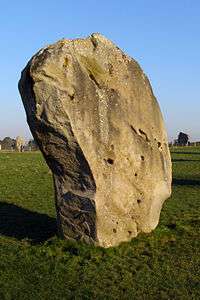Barber surgeon of Avebury

The Barber surgeon of Avebury is the name given to a skeleton discovered in 1938 at Avebury in the English county of Wiltshire.
The body was found underneath a buried megalith by archaeologist Alexander Keiller in 1938. It was dated by coins to the early 14th century, and identified as a barber surgeon by a pair of scissors and a medical-looking probe. The stone was re-erected by Keiller. Many stones of Avebury Henge had been buried, presumably as a result of attempts to de-paganise the site or to clear land for agriculture.

The story of the barber surgeon is one that most visitors to the prehistoric site of Avebury Henge will have heard.
The traditional interpretation goes as follows; a pious traveller was assisting the folk of Avebury in burying the pagan standing stones in the village during the fourteenth century. Alas as he was busily digging out the underside of a stone it fell over, crushing him and entombing him beneath it. Keiller lifted the stone to reinstate it in 1938 and found the man's remains underneath. Items found with the body including coins, scissors and an iron medical probe identified him as an itinerant mediaeval barber surgeon.
Keiller sent the remains to the curator of the museum at the Royal College of Surgeons, whom he felt would appreciate the find. It was thought to have been destroyed during bombing in the Second World War but was rediscovered and re-examined in 1998. A large healed cut wound was noticed on the skull but no evidence of traumatic death was identified and it was suggested that the man had been buried beneath a stone rather than crushed by it.